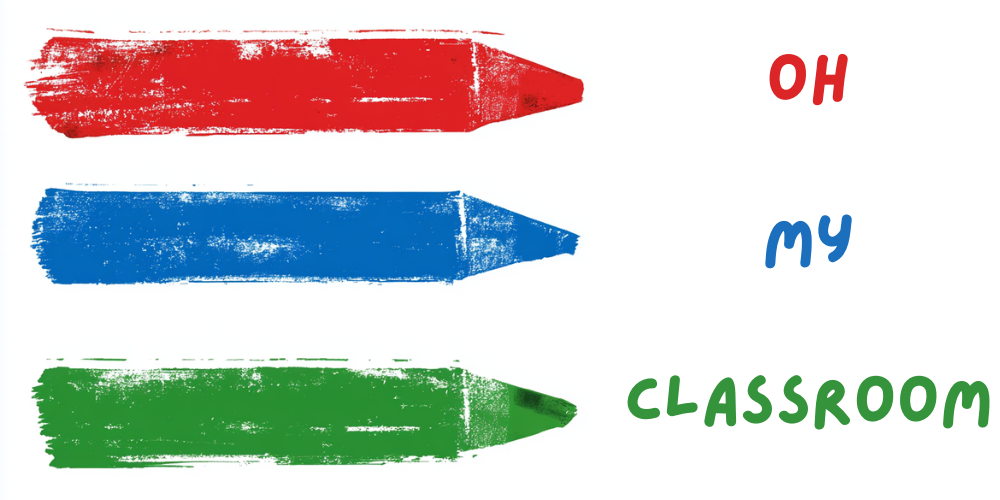As we delve into the world of snowflakes, we’ll discover exciting arts and crafts projects, engaging science experiments, sensory play, and active games.
For preschoolers, this snowy landscape is not just a sight to behold but an opportunity to engage in a variety of snowflake-inspired activities.
So let’s explore some fun & easy Snowflake Craft Activities for Preschool Kids.
Activity 1: Paper Snowflake Cutting
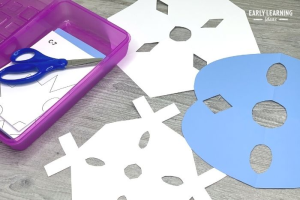
One classic snowflake activity that never fails to delight preschoolers is paper snowflake cutting. All you need is some white paper and child-safe scissors. Start by folding the paper into a square and then show the children how to make small cuts along the folded edges. Once they have cut out their design, unfold the paper to reveal a unique snowflake. Encourage children to experiment with different folding techniques and cutting patterns to create a variety of intricate snowflakes. Display their masterpieces on a bulletin board or string them up as decorations to bring a wintry touch to your classroom or home.
Activity 2: Snowflake Sensory Bin
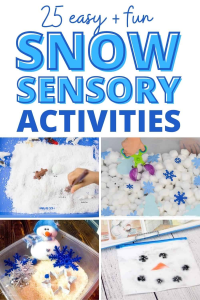
Sensory bins are a fantastic way to engage preschoolers in hands-on play and exploration. Create a snowflake-themed sensory bin by filling a large container with white rice, cotton balls, or even instant mashed potato flakes to mimic snow. Add in plastic snowflake toys, scoops, and containers for scooping and pouring. Encourage the children to feel the different textures, scoop and pour the “snow,” and discover hidden snowflakes buried in the bin. This activity not only stimulates their senses but also promotes fine motor skills, creativity, and imaginative play.
Related: 20 Exciting Loose Parts Play Ideas for Kids
Activity 3: Frozen Watercolor Painting

Combine science and art with a frozen watercolor painting activity. Fill ice cube trays with water and add a few drops of liquid watercolors or food coloring to each compartment. Place a popsicle stick or toothpick in each cube and freeze until solid. Once the colored ice cubes are ready, provide the children with white paper and let them explore the magic of painting with the frozen colors. As the ice melts, the vibrant hues will create beautiful watercolor effects on the paper. Encourage the children to experiment with different techniques, such as blending colors or using the melting ice cubes directly on the paper. This activity encourages creativity, fine motor skills, and an understanding of color mixing.
Activity 4: Snowflake Dance Party
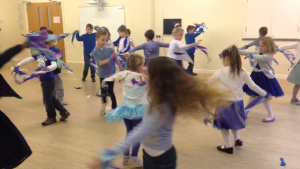
Turn up the music and let the snowflake dance party begin! Clear some space in your classroom or living room and let the children dance and twirl like snowflakes. Encourage them to move gracefully, imitating the delicate and unique shapes of snowflakes. You can even play a game where you call out different snowflake shapes (e.g., starflake, zigzag flake, curlyflake) and the children have to dance accordingly. This activity promotes gross motor skills, coordination, creativity, and imaginative play. It’s a fun and energetic way to celebrate the magic of snowflakes while getting some exercise!
Related: 20 Exciting Pom Pom Activities for Kids
Activity 5: Snowflake Science Experiment
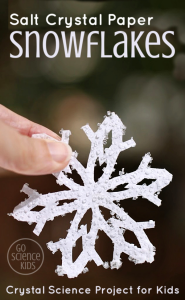
Introduce preschoolers to the fascinating world of science with a snowflake-themed experiment. Begin by discussing how snowflakes are formed and their unique crystalline structures. Then, provide the children with magnifying glasses and invite them to examine real snowflakes or close-up images of snowflakes on paper. After their observation, conduct a simple experiment by filling a jar with hot water and placing an ice cube on top. Encourage the children to observe what happens to the ice cube as it melts and the water temperature changes. Discuss concepts like freezing and melting while relating them to the world of snowflakes. This activity promotes observation skills, critical thinking, and an understanding of scientific concepts in a fun and interactive way.
Activity 6: Snowflake Matching Game
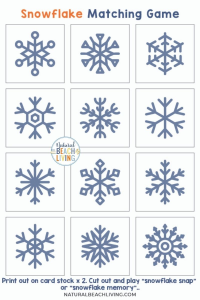
Create a snowflake matching game to enhance preschoolers’ cognitive and memory skills. Cut out several pairs of snowflake shapes from white cardstock or paper, ensuring each pair has a unique design. Mix up the snowflakes and lay them face down on a flat surface. Encourage the children to take turns flipping two cards at a time, trying to find matching pairs of snowflakes. As they turn over the cards, they can observe the different patterns and shapes, improving their concentration and visual recognition skills. This activity can be adapted to various difficulty levels by adjusting the number of cards or introducing more complex snowflake designs.
Activity 7: Snowflake Ice Cube Painting
Combine art and sensory play with a snowflake ice cube painting activity. Fill an ice cube tray with water and add a drop of liquid watercolors or food coloring to each compartment. Place a small plastic snowflake toy or cutout in each cube and freeze until solid. Provide the children with a large sheet of white paper and encourage them to glide the frozen snowflakes across the paper, leaving trails of color behind. As the ice melts, the colors will mix and blend, creating beautiful abstract artwork. This process-based activity promotes fine motor skills, creativity, and experimentation with different textures and colors.
Activity 8: Snowflake Story Time
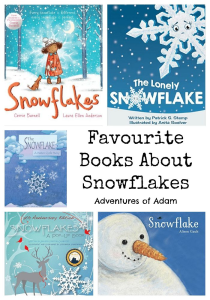
Immerse preschoolers in the enchanting world of snowflakes through a snowflake-themed storytime. Choose age-appropriate books that explore the magic of snowflakes, such as “The Snowflake: A Water Cycle Story” by Neil Waldman or “Snowflake Bentley” by Jacqueline Briggs Martin. Gather the children in a cozy reading corner and read aloud the selected books, engaging them in discussions about snowflakes, winter, and the beauty of nature. Extend the activity by inviting the children to create their own snowflake illustrations or retell the story using props and puppets. This activity fosters language development, imagination, and a love for reading.
Activity 9: Snowflake Sensory Salt Tray

Engage preschoolers in a tactile and calming sensory activity with a snowflake salt tray. Fill a shallow tray or baking dish with a layer of salt, creating a smooth surface. Encourage the children to use their fingers or small tools to trace and draw snowflake patterns in the salt. They can experiment with different movements and techniques, such as swirling, zig-zagging, or tracing straight lines. As they manipulate the salt, they’ll experience the sensory delight of its texture and develop fine motor skills. This activity also provides an opportunity to discuss the unique symmetry and intricacy of snowflake designs.
Activity 10: Snowflake Freeze Dance

Put a wintry twist on the classic freeze dance game by incorporating snowflake-themed movements. Play music and encourage the children to dance and twirl like falling snowflakes. Randomly pause the music and call out a specific snowflake shape or pose, such as “freeze like a starflake” or “freeze with your arms extended like a snowflake’s branches.” The children must freeze in that position until the music starts again. This game promotes listening skills, following directions, and gross motor coordination while adding a delightful snowy element to a beloved activity.
Activity 11: Snowflake Puzzles

Engage preschoolers in problem-solving and fine motor skill development with snowflake puzzles. Print out or draw snowflake patterns on sturdy paper or cardboard and cut them into puzzle pieces. Mix up the pieces and let the children assemble the puzzles, connecting the matching snowflake shapes. You can adjust the difficulty level by varying the number of puzzle pieces or introducing more intricate snowflake designs. This activity encourages spatial awareness, hand-eye coordination, and logical thinking while celebrating the beauty of snowflakes.
Activity 12: Snowflake Toss Game

Create a fun and active snowflake toss game to promote gross motor skills and hand-eye coordination. Set up a target area using buckets or baskets with different point values. Cut out large snowflake shapes from colored paper or fabric and attach them to the buckets. Give the children soft bean bags or rolled-up socks to toss into the buckets, aiming to land their throws on the snowflake targets. Encourage them to keep score and challenge each other to improve their accuracy. This game not only enhances physical skills but also fosters friendly competition and social interaction.
Activity 13: Snowflake Counting and Sorting
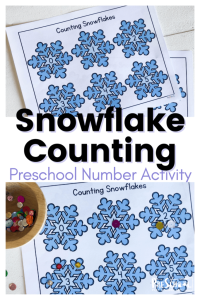
Combine math and sensory play by providing preschoolers with a snowflake counting and sorting activity. Prepare a tray filled with snowflake-shaped objects, such as foam or plastic snowflakes, cotton balls, or white buttons. Invite the children to count the snowflakes and sort them into different categories based on size, color, or shape. They can use sorting trays or create their own sorting system. This activity reinforces counting skills, introduces basic math concepts, and enhances cognitive development while exploring the winter theme of snowflakes.
Activity 14: Snowflake Science: Melting Races
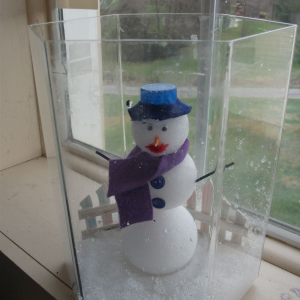
Turn snowflake science into a thrilling competition with a melting race activity. Give each child an ice cube or frozen snowflake shape made from colored water. Set up a designated melting area, such as a shallow tray or container, and mark starting points. The children place their ice cubes on the starting points and race to see whose ice cube melts the fastest. You can discuss factors that affect melting speed, such as temperature or surface area. This activity promotes observation, critical thinking, and scientific inquiry while adding a fun and competitive element.
Activity 15: Snowflake Sensory Dough
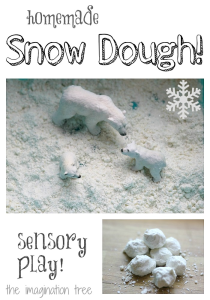
Engage preschoolers’ senses and creativity with homemade snowflake sensory dough. In a large bowl, mix together 2 cups of cornstarch, 1 cup of hair conditioner, and a few drops of blue food coloring (optional). Stir until a soft and moldable dough forms. Add glitter or confetti to mimic the sparkle of snowflakes. Invite the children to explore and play with the sensory dough, molding it into snowflake shapes or creating their own winter scenes. This activity provides a tactile and calming sensory experience while encouraging fine motor skills, imagination, and sensory exploration.
Activity 16: Snowflake Stamp Art

Unleash preschoolers’ creativity with a snowflake stamp art activity. Gather materials such as foam sheets, craft foam stickers, or even carved potatoes. Cut or create snowflake shapes on the foam surfaces, ensuring they have distinct patterns. Pour some tempera paint onto a plate or palette and provide the children with large sheets of paper. Encourage them to dip the snowflake stamps into the paint and press them onto the paper to create beautiful snowflake prints. They can experiment with different colors and arrangements, allowing their imaginations to run wild. This art activity enhances fine motor skills, creativity, and spatial awareness.
Activity 17: Snowflake Freeze Tag

Transform a classic game of tag into an icy adventure with snowflake freeze tag. Designate one child as the “Snowflake Catcher” while the others are “Snowflakes.” When the Snowflake Catcher tags a Snowflake, the caught Snowflake must freeze in place, mimicking the delicate and still nature of a Snowflake. The frozen Snowflake can be unfrozen if another Snowflake tags them. Encourage the children to move gracefully and experiment with different frozen poses. This active game promotes gross motor skills, social interaction, and imaginative play while incorporating the enchantment of snowflakes.
Activity 18: Snowflake Texture Collage

Invite preschoolers to create a snowflake texture collage using a variety of materials. Provide them with a blank canvas, sturdy paper, or cardboard as the base. Set out an assortment of materials such as cotton balls, tissue paper, aluminum foil, glitter, fabric scraps, and craft pom-poms. Encourage the children to use glue or double-sided tape to attach the materials to their canvas, creating a textured snowflake masterpiece. They can explore different textures and experiment with layering and arranging the materials. This activity stimulates sensory exploration, fine motor skills, and artistic expression.
Activity 19: Snowflake Memory Game
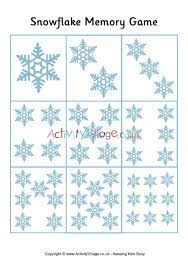
Enhance preschoolers’ memory skills and cognitive abilities with a snowflake-themed memory game. Create pairs of matching snowflake cards by cutting out identical snowflake shapes from cardstock or using printable snowflake templates. Shuffle the cards and place them face down in a grid formation. The children take turns flipping two cards at a time, aiming to find matching pairs of snowflakes. If they find a match, they keep the cards and take another turn. The game continues until all the matches have been found. This activity promotes concentration, memory retention, and turn-taking skills while embracing the snowy theme.
Activity 20: Snowflake Relay Race
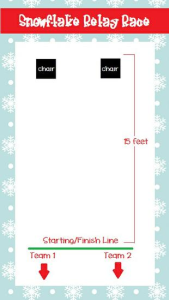
Organize a lively and energetic snowflake relay race for preschoolers. Divide the children into teams and create a racecourse with designated starting and finishing lines. Place snowflake-shaped markers or cutouts along the racecourse at various intervals. Each team member takes turns running from the starting line to a snowflake marker, touching it, and then returning to tag the next teammate. The first team to complete the relay race wins. This activity encourages gross motor skills, teamwork, and friendly competition while incorporating the snowflake motif into an active and engaging game.
